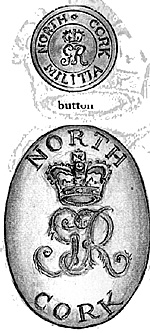 On 4 September, news of the victory at Castlebar had encouraged rebellion to break out in the midlands, firstly in Westmeath and then in Longford. The Insurgents, initially more than 10,000 strong, were in a position to threaten the garrisons at Longford, Granard and Mullingar as well as blocking the Dublin to Sligo road. The news of the rising encouraged Humbert to change his plans and, although the road to Sligo and the north was now clear, he decided to turn
to the south and march to join the insurgents in the midlands. Cornwallis's hunch was provided correct.
On 4 September, news of the victory at Castlebar had encouraged rebellion to break out in the midlands, firstly in Westmeath and then in Longford. The Insurgents, initially more than 10,000 strong, were in a position to threaten the garrisons at Longford, Granard and Mullingar as well as blocking the Dublin to Sligo road. The news of the rising encouraged Humbert to change his plans and, although the road to Sligo and the north was now clear, he decided to turn
to the south and march to join the insurgents in the midlands. Cornwallis's hunch was provided correct.
The rising in the midlands proved to be short lived as many drifted away from the insurrection just as soon as they joined it. What was left of the Westmeath rising defeated by govemment troops under the command of Lord Longford at Wilson's Hospital and Crookedwood on 5 September. On the same day, the Longford insurgents attacked the garrison at Granard but were themselves defeated by troops under the command of Major Porter.
Unaware of the crushing of the insurrection in the midlands, Humbert continued southwards, abandoning his artillery and heavy baggage enroute to increase the speed of his march. By now, many Irish were leaving the Franco-Irish army, which reached Drumkeeran on 6 September and on the next day he crossed the Shannon at Ballintra. It was her'e that the vanguard of Lake's Corps. commanded by Colonel Robert Crauford (later to win fame in the Peninsular War) caught the rear of the Franco-Irish.
The Franco-Irish army camped in the village of Cloone on the evening of 7 September where it was joined by a few survivors of the defeat at Granard. Even with the addition of these, Humbert's army numbered about 850 French and 1,000 Irish.
The next morning, Cornwallis, with 5,000 men and 12 cannon, and Lake with 4,500 men and a similar number of cannon, caught up with Humbert at the village of Ballinamuck. The ensuing battle was swift and the government forces' superiority in artillery and troops proving decisive.
The French fought for about 30 minutes before surrendering. Humbert later reported
Irish Fate
The fate of the Irish was completely different. For them there could be no surrender and no quarter. Although they continued to fight on after the surrender of their French allies, the outcome was never really in doubt. They either died where they stood or had to be hunted down. The yeomanry were particularly ruthless in their pursuit of the fleeing.
With the main army now defeated, Cornwallis could now turn his attention to the mopping up of the remnants of the Franco-Irish around Ballina and Killala. He dispatched General Trench to Mayo to undertake this, whilst Cornwallis himself and the bulk of the army returned to Dublin. He stationed General John Moore (another Officer who was to gain fame during the Peninsular War) in Westmeath in readiness for any new crisis.
Humbert and his men were treated with all the honours of war. They were transported to Dublin along the canal and were considered to be a great spectacle.
The French prisoners created a great deal of attention in Dublin. The Officers were entertained and stayed in the best hotels. Of their role in the rebellion, they claimed that it was a "terrible mistake." [27] Shortly afterwards, Humbert and his men were shipped back to France.
Ballinamuck was not the end of the invasion, however, as insurgents still remained in iKillala. Despite the attempts of the French officers to hide the news of the disaster, the inhabitants of Killala soon became aware of the situation. The French began to lose control of their Irish allies, many of which were intent on vengeance on the
Protestants. With their cause virtually hopeless, the French were now only intent "merely to keep order until they could fnd some British officers to whom they could honourably surrender their swords." [28]
French reinforcements finally did sail on 26 August when Napper Tandy (a rival of Tone's and the most senior United Irish officer in the French Army) left Dunkerque with 270 troops and a vast quantity of supplies on the fast corvette, Anacreon. Slipping past the British blockade,
Tandy landed in Rutland, County Donegal on 16 September. Informed of the situation (although he could hardly believe that Humbert had been defeated) he sailed away the next day.
Unaware of the landing the Franco-Irish army disintegrated and all that was left to face General Trench's 1,200 regulars on 25 September were 800 Insurgents. The ensuing battle was the last of the whole rebellion, the insurgents were crushed and the survivors were hunted down without mercy.
The second day of October 1798 was a day of great celebration In Britain. Not only had the Irish rebellion and French invasion been defeated, but news had just reached London of Nelson's victory at the Battle of the Nlle. However, there was still one flnal issue to be decided. What
had become of the Brest fleet ? On 16 September, General Hardy and 2,800 men, accompanied by Tone himself had left Brest. On 12 October, the fleet was intercepted by Sir John Warren who captured ail but two ships. The greatest prize, however, was the capture of Tone himself who was subsequently sent to Dublin for trial. Wolfe Tone was sentenced to death although he took his
own life before sentence could be carried out.
Aftermath
The aftermath of the rebellion and invasion from the Irish point of view was severe Indeed. Throughout the summer, they had lived with civil war and its associated oppression and reprisal. Following Ballinamuck, those who were not killed during the battle or in its aftermath, were
hunted down by the ycomanry and militia. Leaders of the rebellion were captured, tried and executed. People were tortured and homes destroyed. Many faced a destitute winter in the open and to make matters even worse, famine followed the rebellion.
Whilst Cornwallis may have been shocked at some of the atrocities committed by troops under his command, it is debatable whether he could have prevented them. Throughout the campaign, Cornwallis proved himself to be an able governor and, through his pursuit of Humbert, a
good strategist. He had grasped some of the issues which sent Ireland into rebellion and he saw the need for a level of equality between Catholic and Protestant. Following the rebellion tt was generally agreed, within government, that political union with the rest of Britain was the only way forward. When union was agreed upon, Pitt and his cabinet, swayed by the Dublin Parliament, dismissed the views of Cornwallis and decided to exclude Catholic emancipation from the terms of the Union. "Cornwallis had lost a battle that was to prove more decisive than any others of that
disastrous year." [29]
1798 was not the last invasion attempt. Twice more during the Napoleonic Wars, France gathered troops across the channel. In 1802, the design was probably more to threaten Britain into agreeing to the Treaty of Amiens than invasion itself. Far more serious was that of 1805 when the Grande Armee was stationed in northern France for a time. Defeat at Trafalgar put an end to any realistic hopes of invasion.
The level of French commitment to an invasion of Britain is debatable. There is evidence to support the fact that a landing on British shores was to divert British attention away from the main theatre of war, be this, for example, Flanders or North America, and to force Britain to
withhold reinforcements and withdraw troops currently in action.
Generally, French support was limited to the provision of weapons, money, transportation and a few troops. There was a great reluctance to provide anything more substantial until a degree of success could be demonstrated. When, and if, French support did arrive, it was usually too late. As Thomas Flanagan said of the French "their idea of sport is a small bet placed after the race has been won." [31]
Much has been made of Humbert's inactivity following the victory at Castlebar. Richard Hayes, for instance, is critical of the French commander in chief's decision to remain in Castlebar instead of immediately pursuing a defeated and demoralised enemy.
[32]
But was Humbert really in a position to initiate the pursuit ? His troops were weary, especially after the overnight march and subsequent engagement. He had with him some 800 French
regular infantry and cavalry and about 600 Irish insurgents.
The defeat dealt to the British was not total and many would soon be in the field again. A substantial force was gathering under Cornwallis at Tuam (40 miles to the south east of Castlebar). The Viceroy had left only 1,100 regulars in the capital. [33] Sooner or later, Humbert would have to face these forces in the fleld.
Even if he withdrew all his garrisons, Humbert would have had 1,000 regulars. Regardless of their valour, how reliable would the insurgents be in a pitched battle? Rarely have untrained irregulars overcome regulars in a pitched battle, especially when one of the weapons in the
irregular armoury, namely surprise, is denied. At the outbreak of the 1798 rebellion, the insurgents had the element of surprise and enjoyed initial success whilst facing yeomanry and militia. The balance was re-addressed as more and more regulars went into the fleld.
So even with the prospect of insurrection in the midlands and numbers being swelled by volunteers from other areas, Humbert was not in a position to take on the British in a pitched battle. This is why he dug in at Castlebar, using the time to drill his Irish and awaiting the 4,000 regulars of the Brest expedition (he had requested additional reinforcements of 2,000 men and 15,000 muskets. [34] ) Until these regulars arrived, Humbert was not in a position to leave Castlebar.
Why No Other Rising?
Why then was there not a general rising after Castlebar ? There are a number of reasons for this, flrstly that the summer of 1798 had been flne and warm and a bumper harvest was expected, as long as it could be gathered in. With so much reliance upon the land, it is not surprising that many stayed at home instead of joining the rebellion. [35]
The rebellion had spread like wildflre during the early summer, moving quickly from one district to another. However, the failure of Leitrim and Roscommon to rise acted as a firebreak and helped ensure that rebellion did not spread into Connacht. The rising only took place here because of the arrival of the French, although the invading forces were not numerous enough to encourage the majority to join the Insurgents. Could even the arrival of the French Inspire
areas, which had already risen and suffered the palns of defeat, to rise again ? Certainly by the end of the summer, Leinster had had enough of rebellion. [36]
It was a combination of reasons which finally forced Humbert to leave Castlebar. The French reinforcements had not materialised and Irish volunteers were not flocking to join the Franco-lrish army as Humbert had hoped or had been led to believe. Since landing in Killala until their victory at Castlebar, the French had been almost continuously on the move and during the stay at Castlebar, strain was beginning to show. The French were beginning to show signs of unrest
and there was friction developing between the French and Irish. Humbert no doubt hoped that this unrest would reduce, if not disappear altogether, once the army was on the move again.
Cornwallis was moving ever closer and Humbert had no desire to be trapped in Castlebar. Humbert also needed to have a start over pursing forces and required a degree of freedom to decide upon which destination he would head towards and not have one forced upon him by
the position of enemy troops. Without reinforcements, Humbert was forced to look towards areas of insurrection to increase the size of his army.
His campaign following his departure from Mayo was certainly vigorous to begin with, and was apparently not conducted by somebody contemplating surrender at the earilest opportunity. Was he still hopeful that reinforcements would arrive or perhaps that a sufficient number of insurgents would join the Franco-Irish?
Alternatively, was he concerned with surrendering to a vastly superior force and in so doing enhancing his reputation ? The opponents he faced between Castlebar and Ballinamuck were not the class of opposition that someone eager to enhance a reputation would chose to surrender to.
There was is no doubt that Humbert was very keen to enhance is reputation. He had made great
advancements within the army of the Republic and was keen to rise further. Undoubtedly gallant, it has been said of him that his "heart was better than his head." [37]
The deciding factor between the two sides during the campaign was artillery. The British forces possessed guns in superior numbers which were often better manned. Humbert's victories at
both Castlebar and Collooney were only possible once this artillery had been silenced. At Ballinamuck, the greatest damage during the battle itself was caused by the British
artillery. Irregular forces were not best suited to pitched battles, and against artillery they could often be "blown from the mouth of the cannon like chaff." [38]
The deciding factor at Culloden in 1746, for example, was not the government forces new drill, instigated by Cumberland, but its superior firepower. [39]
Britain was very lucky that many invasion attempts
were dispersed by the weather. Nevertheless British
coastal defence policy relied to the greatest extent upon the
Royal Navy, with the actual constructlon of coastal
defences belag largely reactive. It was extremely
fortunate that a large scale invasion attempt was not
made in 1797 when sections of the Navy were in mutiny.
Probably the first occasion that an integrated policy was
devised (i.e. one which involved the Royal Navy, the
construction of coastal defences and the construction of
second and third lines of defence inland) was during the
Napoleonic Wars. [41]
One result of the 1798 Rebellion was the establishment of a defensive line along the River Shannon which hinged upon Athlone. This was in addition to the defences guarding strategic locations including Dublin Bay, Cork Harbour and Galway Bay. [42] The importance of the Royal Navy is indicated by the number of defences which were built to protect its moorings, be this harbour or estuary.
With thousands of miles of coastline to protect, it is understandable that so much reliance was placed upon the Royal Navy. On occasions, it was the weather, the "Protestant Wind," which prevented a successful invasion, but generally it was that the "command of the sea alone
kept Britain safe from invasion and secured British colonial conquest and essential trade."
[43]
Humbert has been criticised for the speed with which he surrendered at Ballinamuck, and in so doing, leaving the Irish to their fate. But was this betrayal? Had Humbert fought on, what would he have achieved?
Perhaps only to give those who could nee a little more time and prolong the yeomanry's pursuit. Should he then have encouraged the Irish to return home before the battle? But by the time his last hope, the midlands rising, had faded, the British pursuit was too close to enable any more than had already left, to leave. Although Humbert was keen to enhance his reputation (indeed Greaves has stated that Humbert was not ordered to lead the expedition but did so on his own initative'8) he would rather be a live hero than a dead one.
This is not to say that there isn't a case for the betrayal of the Irish by the French, Certainly the expected French assistance did not arrive in time for the main rebellion and what did arrive was too little too late. If Humbert didn't betray the Irish then perhaps the French
government did. France did have an opportunity to conquer Ireland: "It is arguable that the French lost Europe, not before Moscow, but in 1797, when only a Navy in mutiny stood between them and an Ireland on the eve of rebellion." [46]
His exile on St. Helena gave Napoleon Bonaparte time to reflect upon what might have been: "Si au lieu de l'expedition d'Egypte, J'eusse fait celle d'Irlande...que povait itre l'Angleterre aujourd'hul?" [47]
[24] Pakenham, Op Cit. pp: 570-2.
Beckett, J. C. The Making of Modern Ireland. 1603 - 1923 (London, Faber & Faber ltd., 1981).
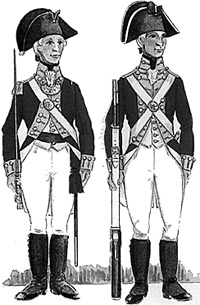 Although Humbert's rearguard managed to extricate itself, the
arrival of Crauford prevented the demolition of the bridge at
"Ballintra". [24]
Although Humbert's rearguard managed to extricate itself, the
arrival of Crauford prevented the demolition of the bridge at
"Ballintra". [24]
"After having obtained the greatest successes and made the arms of the French Republic triumph during my stay in Ireland, I have at length been obliged to submit to a superior force of 30,000 men."
[24]
The Progress of the Captives down the Canal formed a very picturesque and interesting scene. The first (boat) contained the band of the Fermanagh Militia, the second the French officers and the remaining boats were occupied by the privates, amounting to near eight hundred men. Nothing could exceed the nonchalance and merriment with which the French bore their situation, collecting in parties...and singing the Marseillaise.
[26]
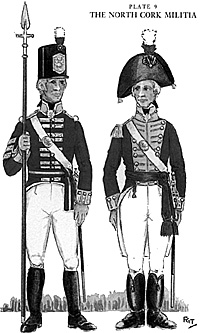 It was the perceived threat from France in 1859 which led to Britain's then most extensive coastal defence building programme, the Royal Commission of 1859. [30] By the twentieth century, the threat was no longer from France but from Germany and although large-scale invasion was not
seriously considered during 1914-18, the threat in 1940 was great. The Channel Islands fell and it is likely that the only factor which prevented invasion was Germany's failure to gain control of, not the sea, but the sky.
It was the perceived threat from France in 1859 which led to Britain's then most extensive coastal defence building programme, the Royal Commission of 1859. [30] By the twentieth century, the threat was no longer from France but from Germany and although large-scale invasion was not
seriously considered during 1914-18, the threat in 1940 was great. The Channel Islands fell and it is likely that the only factor which prevented invasion was Germany's failure to gain control of, not the sea, but the sky.
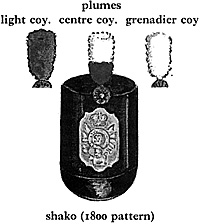 News of a rising in Roscommon proved to be false so instead he turned his attention to the north, first to Sligo and then possibly towards Ulster where there had been a rising in June. This would have the added advantage of keeping the Franco-Irish in contact with the coast (at least for the first part of the march) should
reinforcements land. One can only speculate as to exactly when Humbert reallsed that his venture would not succeed and that it was only a matter of time before his army would be defeated. Did he, as some historians have argued, resign himself to this fact whilst at
Castlebar or was it later?
News of a rising in Roscommon proved to be false so instead he turned his attention to the north, first to Sligo and then possibly towards Ulster where there had been a rising in June. This would have the added advantage of keeping the Franco-Irish in contact with the coast (at least for the first part of the march) should
reinforcements land. One can only speculate as to exactly when Humbert reallsed that his venture would not succeed and that it was only a matter of time before his army would be defeated. Did he, as some historians have argued, resign himself to this fact whilst at
Castlebar or was it later?
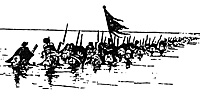 If firepower did not break the irregulars and the issue was decided by hand-to-hand combat then the outcome could be quite different. The heaviest government casualties at Culloden were suffered by Barrell s regiment who were amongst the handful of regiments to come into direct contact with the Jacobites. [40]
If firepower did not break the irregulars and the issue was decided by hand-to-hand combat then the outcome could be quite different. The heaviest government casualties at Culloden were suffered by Barrell s regiment who were amongst the handful of regiments to come into direct contact with the Jacobites. [40]
Footnotes
[25] Humbert, General J. taken from Pakenham, T. The Year of Liberty (London, Oranada Publishing Ud., 1972) p 373
[26] Contemporary account taken from Pakenharn, T. The Year of Liberty (London, Granada Publishing Ltd., 1972) p 375
[27] Pakenham, Op Cit. p 575
[28] Pakenham, Op Cit. p 578
[29] Pahenham, Op Cit. p 387
[30] Saunders, Op Cit. P 171
[31] Flanagan, T. The Year of the French (London. Macmillan Ltd., 1979) p 85
[32] Hayes, Op Cit. p 56
[33] Pakenham, Op Cit. p 550
[34] Hayes, Op Clt. p 58
[35] Pakenham, Op Cit. p 365
[36] Pakenham, Op Clt. p 565
[37] Greaves, Op Cit. p 58
[38] Kenny, M. The 1798 Rebellion (Dublin, Town House and County House, 1996) p 57
[39] Reid, S. Like Hungry Wolves (London, Windrow and Greene Ud., 1994) pp 92-8
[40] Reid. Op Cit. pp 98-100
[41] Saunders. Op Cit. p 151
[42] Saunders, Op Cit. pp 146-7
[43] Pakenham, Op Cit. p 24
[44] Reilly, Op Cit. p 334
[45] Greaves, Op Cit. p 58
[46] Thompson, E. P. The Making of the English Working Class (London, Penguin Books Ud., 1991) p 470
[47] Napoleon Bonaparte quoted in Las Casas Memoires (1823) taken from Pakenham, T. The Year of Liberty (London, Oranada Publishing Ltd.. 1972) p 385. Approximately translated as "If in place of the Egyptian expedition, I had made one to Ireland we could be in England today."
Bibliography
Best, G. War and Soc/ety in Revo/utionary Europe, 1770 - 1870 (Leicester, Leicester University Press, 1982).
Boyce, D.G. & O'Day. A. (Editors) The Making of Modern Irish History (London, Routiedge, 1996)
Buffinton, A. H. The Second Hundred Years War, 1689 - 1815 (London. G. Bell and Sons Ltd., 1930).
Cruise O'Brien, M. 11 C. Ireland - A Concise History (London, BCA, 1992).
Donovan. K. 'Who fears to speak of '9S 7' The Irish Tlmes (28 January 1997) p 15.
Finn, J. & Lynch, M. Ireland and England 1798 - 1922 (London, Hodder and Stoughton, 1995).
Planagan. T. The Year of the French (London, Macmillan Ltd., 1979).
Polley, T. (editor) Eyewitness to 1798 (Cork, Mercier Press, 1996).
Foster, R. r. (Editor) The Oxford Illustrated History of Ireland (Oxford, Oxford University Press, 1989).
Creaves, C. D. Theabald Wolfe Tone and the Irish Nation (Dublin, Connolly Fublicatlons Ltd., 1989).
Hover, M. Waffare in the Age of Bonaparte (London, Cassell Ltd., 1980).
Hayes, R. The Last Invasion of Ireland (Dublin, Olil and Macmillan Ltd., 1979).
Hayes - McCoy, G. A. Irish Battles - A Military Hlstory of Ireland (Belfast. The Appletree Press Ltd., 1990).
Jones, Commander E. H. S.. RN An Invasion that Failed (Oxford, Basil Blackwell, 1950).
Kenny, M. The 1798 Rebellion (Dublin, Town House and County House, 1996).
McAnally, Sir H. 'The French invasion of Connacht 1798: some problems in number;', Bulletin of the Irish Committee of Historical Sciences (57) (March 1945) pp 1-2.
Pakenham, T. The Year of Liberty (London, Granada Publishing Ltd. 1972).
Reid, S. Like Hungry Wolves (London, Windrow and Greene Ltd. 1994).
Reilly, R. William Pitt the Younger (New York, Q.P. Putnam's Sons, 1979).
Sarrazin, General J 'Notes sur l'Expeditlon d'lrlande', appeared as Hayes, R. 'An Officer's Account of the French Campaign in Ireland In 1798', Irish Sword (2) (1955) pp 110-119 and pp 160-171.
Saunders, A. Fortress Britain - Artillery Fortification in the British Isles and Ireland (Liverpool, Beaufort Publishing Limited. 1989).
Smurthwaite, D. The Ordnance Survey Complete Guide to the
Battleflelds of Britain (Exeter, Webb and Bower (Publishers) Limited, 1984).
Stewart, A. T. Q. The Summer Soldiers - The 1798 Rebellion in Antrim & Down (Belfast, The Blackstaff Press Ud.. 1995).
Szechi. D. The Jacobites - Britain and Europe, 1688-1788 (Manchester, Manchester University Press, 1994).
Thompson, E. P. The Making of the English Working Class (London, Pennuin Books Ud.. 1991).
Back to Age of Napoleon No. 28 Table of Contents
Back to Age of Napoleon List of Issues
Back to MagWeb Master List of Magazines
© Copyright 1998 by Partizan Press.
This article appears in MagWeb (Magazine Web) on the Internet World Wide Web.
Other military history articles and gaming articles are available at http://www.magweb.com